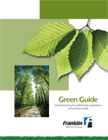|  Get Your Guide to Formaldehyde Regulations Get Your Guide to Formaldehyde Regulations
If you have been trying to get your arms around ever-tightening formaldehyde restrictions, you might want to get your hands on a copy of our new informational booklet, Green Guide: Understanding Formaldehyde Regulations Around the World. The six-page booklet is an easy-to-understand guide to limits on formaldehyde emissions in the U.S., Europe, Asia and other global markets – including California Air Resources Board (CARB) regulations. The guide explores CARB regulations on composite wood products, which are being phased in over three years. (The first phase became effective January 2009.) It includes a schedule showing effective dates for emission standards on the three products CARB targets (plywood, particleboard and fiberboard); and discusses the merit of using a formaldehyde-free adhesive to ensure compliance with CARB standards, given that wood typically contains some natural amount of formaldehyde. Beyond giving you information about formaldehyde emissions, we at Franklin Adhesives & Polymers also can help you meet them: Many commonly used Titebond and Multibond wood adhesives support manufacturers of composite wood products in meeting formaldehyde emissions standards. We also recently introduced Multibond 4000 FF, a completely formaldehyde-free, water-resistant, one-part x-PVAc adhesive. For your copy of the Green Guide, visit www.franklinadhesivesandpolymers.com or e-mail marketing@franklininternational.com. |